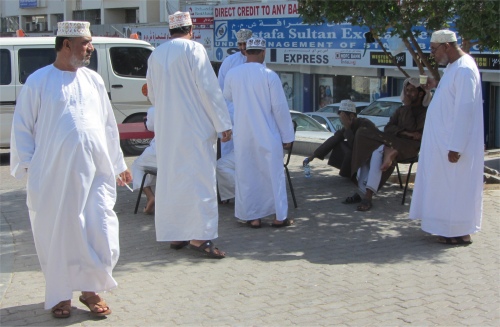 A Bevy of Shared Cab Drivers Putting the World to Rights |
First thing on the agenda though was a visit to the Sultan's Armed Forces Museum. My map indicated it was a short distance beyond the C.B.D., so after a hearty breakfast of fruit followed by scrambled eggs, meatballs in garlic sauce, and spring rolls, I set off to walk. It would only take me half an hour to reach it.
I entered the museum from the far end of a military base, not exactly made clear on my map, passed through a checkpoint manned by smartly dressed soldiers, and arrived at the museum reception manned by more smartly uniformed men. The whole show reeked of professionalism. A member of the Kings Guard was assigned to give me a personal guided tour, a friendly chap who relied almost totally on my ability to read the English text on the display boards.
The museum was located in the Bait Al-Falaj Fort, which stood at the far northern end of Ruwi plain, an area surrounded by high mountains with very rough and tough narrow routes diverging towards the sea from the south east and north east. The plateau was open to the west of the country by a strategic passage leading to Al Battinah and Al Dakhiliah regions. The fort, which took its name from the pure falaj water running past it, lay in a strategic central position protecting the great trading port and commanding all routes leading to and from the region.
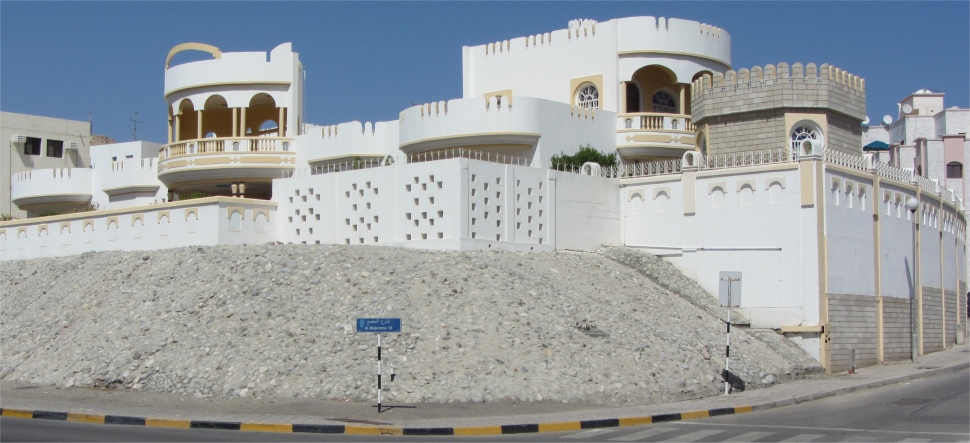 Ruwi Residential Properties |
The museum was organised into three zones. Inside the old fort, the lower rooms gave a comprehensive outline of Oman's history, and the upper rooms explored Oman's international relations and military prowess. Outside stood exhibits of military hardware such as planes, helicopters, boats, and rough terrain vehicles.
 Bait Al-Falaj Fort, now the Sultan's Armed Forces Museum |
The Ya'rubiy period in Oman is associated with the accession to power of Imam Nasser bin Murshid in 1624. He was the most powerful of the Ya'rubiy Imams, and his reign marked the beginning of Oman's independence from Portuguese control. The royal family was started by Imam Ahmed bin Said, who ruled Oman from 1741 until 1775. He was Sohar governor at the end of Al Ya'aribah reign. He expelled the Persians from Oman. The dynasty reached its zenith during the reign of Sayyid Said bin Sultan (r. 1806-1856), when Oman became the centre of a vast sea-borne empire along the coasts and islands of eastern Africa and the Persian Gulf. In 1916, Sayyid Taimour bin Faisal issued the first law of Military Service. It included pay codes, allowances, gratuities, punishments, penalties and pensions.
Naturally, the museum gave a brief résumé of Sultan Qaboos. Sultan Qaboos bin Sa'id was born in Salalah in Dhofar on 18th November 1940. He is the only son of Sultan Said bin Taimur and princess Mazoon al-Mashani. He received his primary and secondary education at Salalah and Poona, India and was sent to a private educational establishment in Suffolk, England at the age of sixteen. At twenty, he entered the Royal Military Academy Sandhurst, and after graduating from Sandhurst, he joined the British Army and was posted to the 1st Battalion The Cameronians (Scottish Rifles), serving in Germany for one year. He also held a staff appointment with the British Army. After his military service, Sultan Qaboos studied local government subjects in England and, after a world tour, returned home to Salalah where he studied Islam and the history of his country.
Oman's military history was explored using weapons, equipment, maps, dioramas, uniforms, and medals relating to all the armed services. Outside, larger museum items such as vehicles, aircraft, small ships, and full size dioramas were located. The emphasis was on 1960s and onwards, with a heavy bias to British-equipment, including the aircraft selection. The displays also included several full-sized dioramas such as wartime field headquarters and a military hospital with an army of mannequins in current uniforms. The last things I expected to see in this once desert like compound were a couple of vessels, a wooden dhow-type vessel, and a very recent looking surface-surface missile boat. Also on show was the first car owned by Sultan Qaboos when he became Sultan, a Cadillac with inches-thick bulletproof glass.
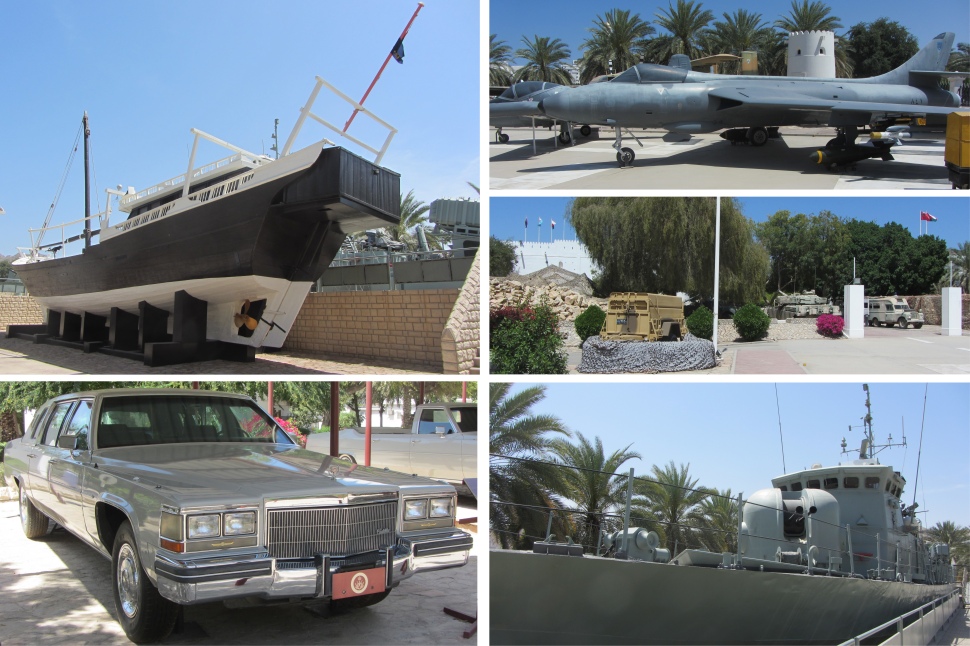 Museum Outside Exhibits |
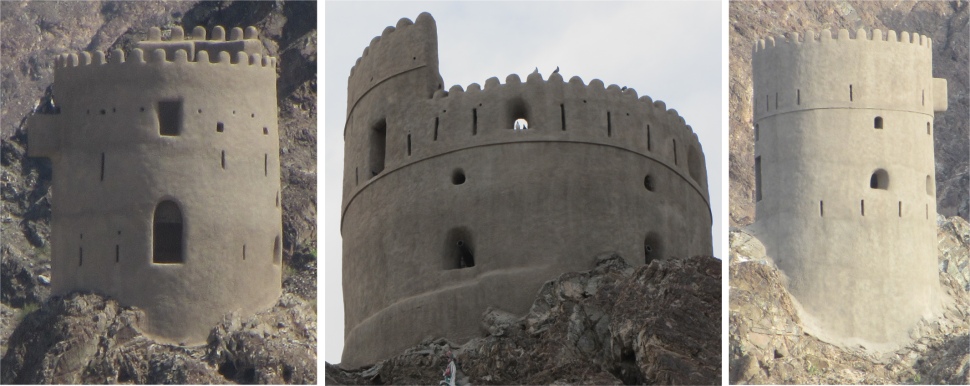 Mutrah Watch Towers |
 Top Souq Entrance |
 Ornate Minaret |
Apart from wanting to purchase my last couple of presents in the souq, I wanted to savour the salty air by the sea again; a perfect antidote to the baking heat. I took a stroll by the sparkling harbour, gulping in lungful's of salt tanged air, slightly tinged with the smell of oil leaking from ships in the harbour. A roadside cafe helped me to replenish lost fluids, a large glass of spiced mint lassi proved most refreshing.
Then there was nothing for it but to bite the bullet and dive into the souq. I had grown quite ruthless in handling the various stall holders in such places, avoiding eye-contact and using liberal quantities of "La, shukran (no thank you)." Much of the goods were imports from India and China, and the air was heady with the large quantities of frankincense being burned at the numerous stalls selling it by the ton.
 Dusk at Mutrah |
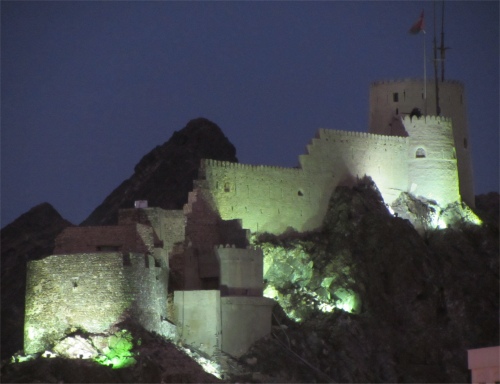 Mutrah Fort at Night |
Submerging myself back into the souq, I made my purchases, and celebrated inside with a strong black coffee. A group of old Arabs in traditional garb made space for me on a stone bench, all mumbling reminiscences through toothless gums to one another in a tongue I could not understand.
Returning back to the Corniche when the light was slowly fading, and the austerity of rock and sand on the surrounding hills was being softened by borrowed colours, I joined a throng of folk of all nationalities watching the main coast road to Old Muscat. The long road had been proclaimed as parking-free for the day, and a constant stream of police cars had been pulling in to issue instant fines to any transgressors. Gradually the traffic on the road petered out, and at dusk it was traffic free. Then, in a flurry of flashing lights, a convoy of black cars sped past at 120km/hr., and the circus was gone. Apparently Prince Charles had visited Nizwa today, and he was now heading under high speed escort to the Sultan's Palace at Old Muscat. We just kept missing each other.
 Cruise Ship Leaving |
It was by now dark, so I grabbed a cab back to Ruwi and endeavoured to chat to the driver. His thin lips were pinched, and there were deep lines around his mouth and nose. He mentioned the British President visiting, and I corrected him by telling him it was Prince Charles, the queen's eldest son. "The President," he insisted. We went around a circular conversation for a while, but the gulf in understanding was too large, so I let it go.
Back at base, a cool shower followed by another interesting Omani meal, a couple of beers, and I was done for the day.
